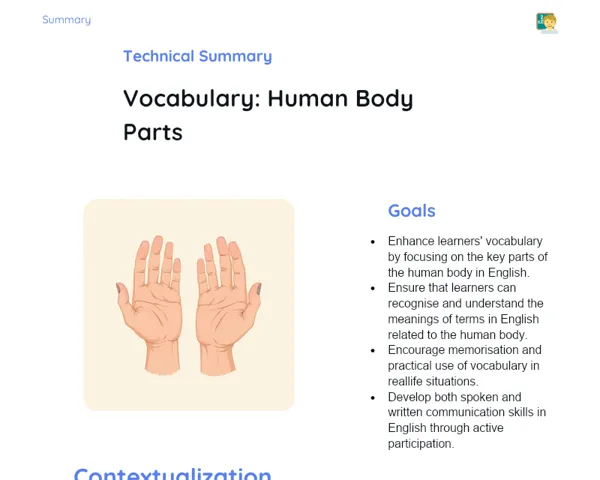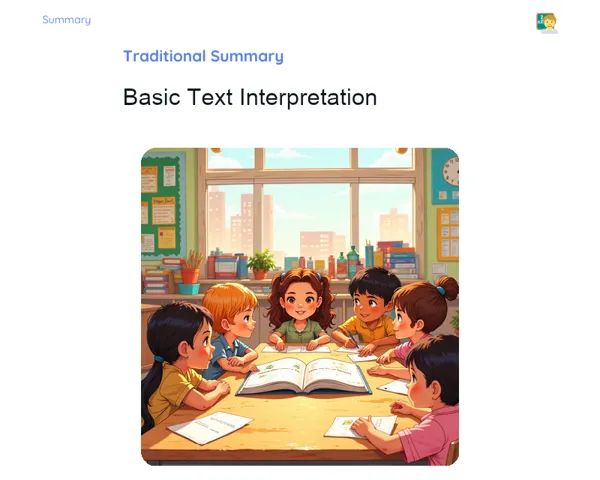Summary Tradisional | Vocabulary: Human Body Parts
Contextualization
In this module, we'll dive into the vocabulary of human body parts in English, which is vital for communication in various day-to-day situations. Knowing the names of body parts is crucial not just for medical consultations but also for grasping instructions in physical education classes, describing symptoms in emergencies, or even while enjoying movies and series in English. Developing this vocabulary means you can express yourself clearly in different contexts, enhancing both interaction and understanding.
Interestingly, many terms related to the human body in English have roots in Latin and Greek, which can aid in grasping medical and scientific terminology. For instance, the word 'cardiology' comes from the Greek 'kardia', meaning heart. By learning these terms, you not only build your English vocabulary but also gain insight into anatomy and the functioning of the human body, fostering a greater awareness of health and well-being.
To Remember!
Head
The head is one of the most intricate and essential parts of the human body. It comprises several structures that perform key functions. The head includes the skull, which protects the brain, a major part of the body, responsible for controlling all bodily functions. The face consists of eyes, nose, mouth, and ears, each playing a specific role.
The eyes are our organs of vision, enabling us to see the world around us. They are fundamental for daily activities and non-verbal communication. The nose facilitates breathing and contributes to our sense of smell, allowing us to detect various scents. The mouth is vital for eating and is key for verbal communication through speech.
The ears are responsible for hearing and balance, capturing sounds and assisting in maintaining body stability. Hair serves protective functions, shielding the scalp from sunlight and aiding in temperature regulation.
-
Skull: Protects the brain.
-
Eyes: Allow us to see.
-
Nose: Key for breathing and sense of smell.
-
Mouth: Essential for eating and communication.
-
Ears: Crucial for hearing and balance.
-
Hair: Protects the scalp and aids in temperature control.
Torso
The torso is the central part of the human body and includes several important structures that support and protect internal organs. The neck connects the head to the body, allowing for mobility and support. The shoulders are vital for arm movement and for carrying out various daily tasks. The chest houses vital organs such as the heart and lungs, safeguarded by the rib cage.
The back includes the spine, which is essential for maintaining posture and facilitating body movement. The spine protects the spinal cord, an extension of our central nervous system. The abdomen holds important organs like the stomach, liver, and intestines, crucial for digestion and other bodily processes.
The waist connects the abdomen to the lower limbs. It plays a key role in body mobility and balance and enables a range of movements.
-
Neck: Links the head to the body and allows movement.
-
Shoulders: Enable arm movement.
-
Chest: Houses and protects the heart and lungs.
-
Back: Contains the spine.
-
Abdomen: Houses crucial organs for digestion.
-
Waist: Connects the abdomen to the lower limbs.
Upper Limbs
The upper limbs are essential for performing a wide array of daily activities. They consist of the arms, which include the humerus, radius, and ulna. The arms allow for a variety of movements, such as lifting, pushing, and pulling. The elbows are joints connecting the arm to the forearm, enabling bending and straightening.
The wrists connect the forearm to the hands, providing flexibility for delicate tasks like writing and handling small items. The hands are incredibly versatile and include fingers, which are crucial for fine motor skills. Our hands are used for countless activities, from holding objects to executing precise movements.
The upper limbs are fundamental for engaging with our environment and performing tasks requiring strength, precision, and coordination. They enable daily activities like cooking, writing, and playing sports, and are also vital for non-verbal communication through gestures.
-
Arms: Enable a wide range of movements.
-
Elbows: Joints allowing bending and straightening of the arms.
-
Wrists: Enable flexibility for fine tasks.
-
Hands: Versatile and essential for fine motor coordination.
-
Fingers: Key for precise movements.
Lower Limbs
The lower limbs support the body's weight and enable movement. They include the legs, which are comprised of the femur, tibia, and fibula. The legs facilitate actions like walking, running, and jumping. The knees are joints connecting the thigh to the leg, allowing for bending and straightening.
The ankles link the leg to the feet, providing the mobility necessary for movement. The feet are crucial for maintaining balance and supporting the body's weight, featuring toes that help with stability and even weight distribution.
The lower limbs are essential for mobility and performing physical activities, allowing for a wide range of movements important for sports and exercises. They also play a key role in supporting the body and maintaining good posture.
-
Legs: Allow walking, running, and jumping.
-
Knees: Joints facilitating bending and straightening of the legs.
-
Ankles: Provide mobility.
-
Feet: Support and aid in balance.
-
Toes: Assist with stability and weight distribution.
Key Terms
-
Skull: Skull
-
Face: Face
-
Eyes: Eyes
-
Nose: Nose
-
Mouth: Mouth
-
Ears: Ears
-
Hair: Hair
-
Neck: Neck
-
Shoulders: Shoulders
-
Chest: Chest
-
Back: Back
-
Abdomen: Abdomen
-
Waist: Waist
-
Arms: Arms
-
Elbows: Elbows
-
Wrists: Wrists
-
Hands: Hands
-
Fingers: Fingers
-
Legs: Legs
-
Knees: Knees
-
Ankles: Ankles
-
Feet: Feet
-
Toes: Toes
Important Conclusions
In this lesson, we’ve looked at the vocabulary of human body parts in English, focusing on the significance of each part and its functions. We began with the head, moved on to the torso, upper limbs, and lower limbs, detailing each part along with their respective terms in English and their key roles. This thorough approach allows our students to better understand how each body part contributes to everyday activities and overall health.
Grasping the vocabulary related to human body parts in English is essential for effective communication in many contexts, such as medical consultations, physical education classes, and travel experiences. Being able to identify and understand the functions of these parts fosters interaction in situations where precision and clarity are vital. Moreover, many terms have roots in Latin and Greek, which enriches the knowledge gained.
Lastly, it's crucial for students to keep practising and reviewing this vocabulary to cement their learning. We encourage them to explore more on this subject, using extra resources like dictionaries, vocabulary exercises, and practical interactions in English. This understanding not only enhances their language skills but also promotes a deeper awareness of human anatomy and health.
Study Tips
-
Frequently review the terms you’ve learned using flashcards or vocabulary lists to strengthen memorization.
-
Practice using the vocabulary in English during everyday situations, like describing symptoms in a mock medical consultation or during physical activities.
-
Make use of multimedia resources, such as videos and English learning apps focusing on vocabulary related to human body parts for more engaging practice.



